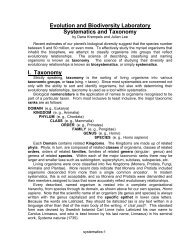LABORATORY 4 Creating an Effective Scientific Presentation
LABORATORY 4 Creating an Effective Scientific Presentation
LABORATORY 4 Creating an Effective Scientific Presentation
You also want an ePaper? Increase the reach of your titles
YUMPU automatically turns print PDFs into web optimized ePapers that Google loves.
F. DiscussionThis is the most import<strong>an</strong>t section of your presentation, <strong>an</strong>d should not merely be are-statement of your results. In your discussion, you must <strong>an</strong>alyze <strong>an</strong>d explain yourresults. Follow these simple guidelines.1. Link your results to your original hypotheses.2. Which hypotheses was/were excluded? Which was not?3. Explain your experimental observations in specific terms. Describe what hashappened in terms of molecular interaction, physics (kinetics), behavior, etc. DONOT make statements such as: "The reaction was faster because it had agreater reaction rate." (The absurdity of this statement should be self-evident.)4. The world will not stop turning if your results are not what you expected.More import<strong>an</strong>t th<strong>an</strong> "accurate results" (if there is such a thing) is logicalexpl<strong>an</strong>ation of your observations.5. Discuss possible sources of experimental error (NOT hum<strong>an</strong> error) <strong>an</strong>d how theymight have affected your results.6. Draw overall conclusions--give summary statements.7. Most import<strong>an</strong>tly, what do your findings suggest about the next step ininvestigating the function of catalase? What is the next set of competinghypotheses you might pose to address these new questions?G. AcknowledgementsModern scientific research is not done in a vacuum. Be sure to cite all sources ofbackground information. If you would like to th<strong>an</strong>k particular persons or entities for <strong>an</strong>yassist<strong>an</strong>ce given during the design of your experiment, its execution, or the preparationof your presentation, then <strong>an</strong> acknowledgement slide at the end of the show is a niceway to show your appreciation. (Gr<strong>an</strong>ting agencies expect this! So if mom <strong>an</strong>d dad arepaying your tuition, you c<strong>an</strong> th<strong>an</strong>k them here.)H. Questions <strong>an</strong>d AnswersNow that you have presented your work to your colleagues, it is time to receive theirquestions, <strong>an</strong>d possibly their criticisms. Open the floor to questions, <strong>an</strong>d be ready to<strong>an</strong>swer. Prepare yourself by reading all text references about enzymes, <strong>an</strong>d also knowextra information about your specific experimental variable.If you are in the audience, be <strong>an</strong> active particip<strong>an</strong>t in the question-<strong>an</strong>d-<strong>an</strong>swerperiod, as this is where flaws in experimental design c<strong>an</strong> be pointed out so that futureexperiments will be more informative.I. OPTIONAL: H<strong>an</strong>doutsAs staunch environmentalists, we in the biology department discourage w<strong>an</strong>tonwaste of paper. Please provide a h<strong>an</strong>dout ONLY if you feel it is necessary to adequateunderst<strong>an</strong>ding of your presentation. It is probably NOT necessary for this presentation.In scientific meetings, a good h<strong>an</strong>dout c<strong>an</strong> keep audience members from becomingfrustrated if they c<strong>an</strong>’t write down what is on every slide. You don’t w<strong>an</strong>t yourcolleagues to become so overwhelmed that they lose interest. A brief, appropriateh<strong>an</strong>dout c<strong>an</strong> help your audience stay focused on the speaker. But remember a slideshould be concise, not <strong>an</strong> oce<strong>an</strong> of text or table.On the following pages you will find critique sheets for evaluating the work ofyour classroom colleagues. Use one sheet per presentation.3-5
















